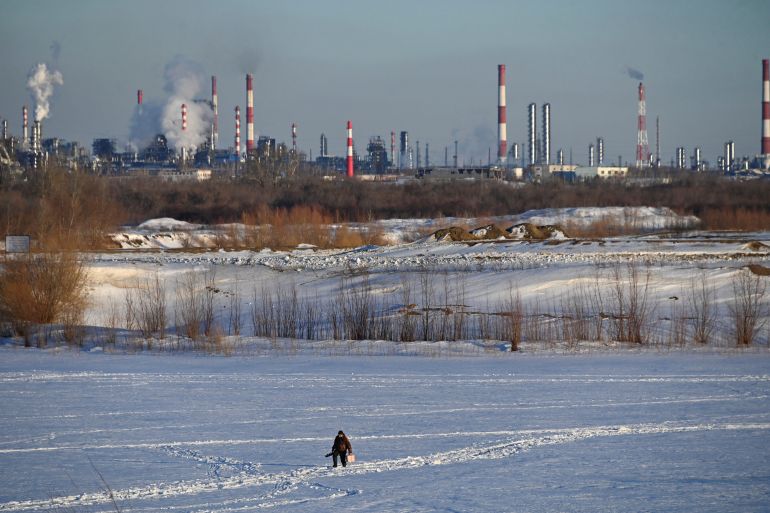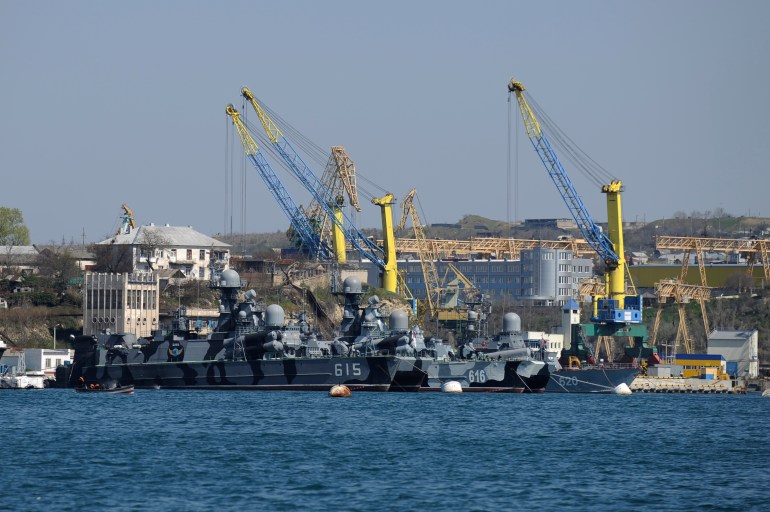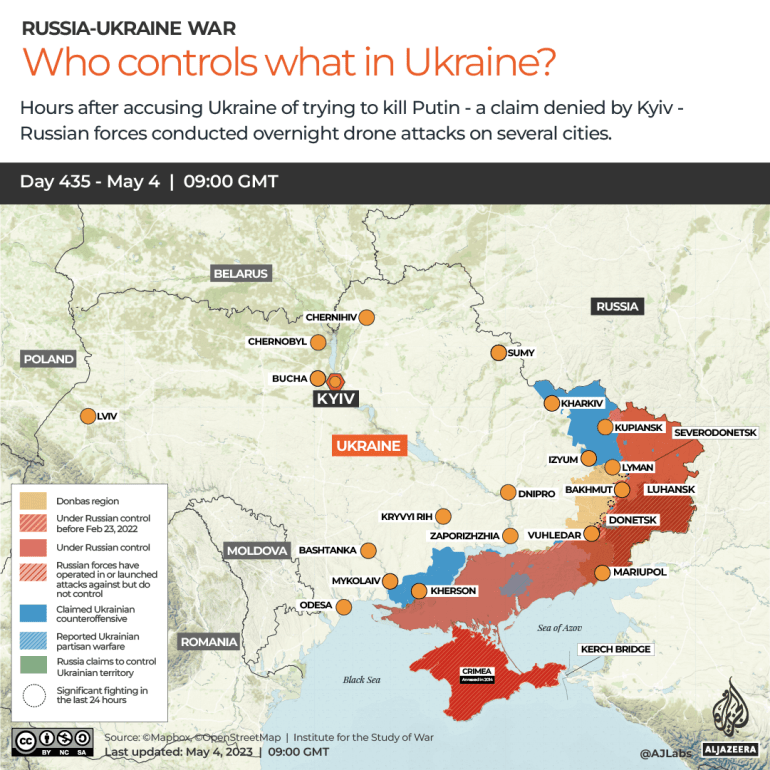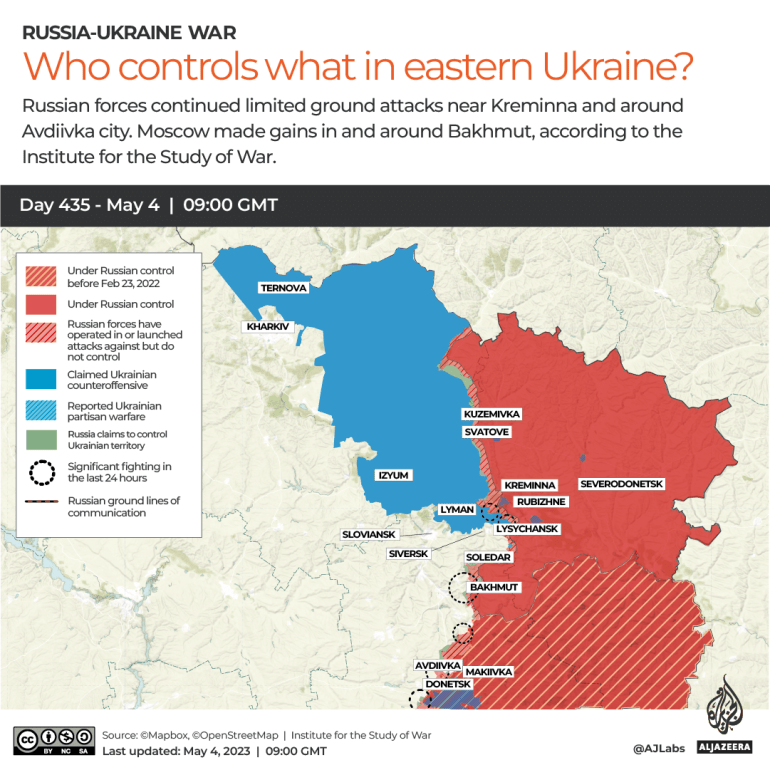Ukraine targets Russian fuel sites ahead of counteroffensive
Attacks intensified, more civilians were killed and Ukraine said its counteroffensive preparations were almost ready.

Drones, missiles and cross-border artillery took centre stage during the 62nd week of Russia’s war in Ukraine, as the 63rd began with a dramatic allegation from Moscow – that Ukraine made an attempt on Russian President Vladimir Putin’s life.
Ukraine may have targeted Russian fuel depots – a possible preamble to its expected counteroffensive. Russia, meanwhile, sharply intensified strikes against Ukrainian civilians, claiming dozens of lives.
Keep reading
list of 3 itemsUkraine says 21 killed in Russian attack on Kherson
Zelenskyy denies Russian claim Ukraine tried to assassinate Putin
Ukraine was likely responsible for explosions in Kozacha Bay, near Sevastopol on the Crimean Peninsula, where the Russian Black Sea Fleet has a base, on April 29.
Footage showed a massive black mushroom cloud rising from a fuel tank park. Ukrainian military intelligence spokesman Andriy Yusov said 10 tanks containing 40,000 tonnes of refined oil products had been destroyed.
Mikhail Razvozhayev, the Russia-installed governor of occupied Crimea, confirmed that a Ukrainian drone had struck an oil tank, sparking a fire more than 1,000 square metres (10,764 square feet) in size.
A Russian military blogger said two drones had destroyed four fuel tanks. Another Russian blogger said 10 Mugin-5 UAVs had been launched against the fuel tanks from Shkilnyy airfield in Odesa, and some were shot down.

Russia also blamed Ukraine for a fire at the Ilsky oil refinery near the Black Sea port of Novorossiysk on May 4. Ukraine did not claim responsibility for the strike.
Both fuel facilities were struck within a day of Russian air attacks on Ukrainian civilians.
A day before the Kozacha Bay attack, missiles fired from Russian territory landed in Uman, in central Ukraine, killing 20 civilians, including five children.
Russia acknowledged the attack, saying it had targeted a training ground for reservists.
Whereas the Russian defence ministry claimed it had struck all targets, Ukraine said it had shot down 21 of 23 missiles.

Overnight before the Ilsky fire, Ukraine said Russia had launched dozens of UAV attacks on Ukrainian soil for a second day.
“The invaders launched up to 24 Shahed-136/131 attack drones … The Air Force of Ukraine, in co-operation with other air defence units, shot down 18 attack drones,” the air force said on Telegram.
Ukraine has long sought to punish Russia for its attacks on non-combatants, and to counter its ability to reach deep inside Ukrainian territory where no battles are taking place.
On September 7, Valery Zaluzhny, the head of Ukraine’s armed forces, said long-range weapons supplied by the West would be key to winning the war in 2023.
“The enemy is capable of inflicting pinpoint strikes on targets in the entire depth of the country’s territory with impunity. This should be considered as the center of gravity of the Armed Forces of the Russian Federation from a military point of view. As long as this situation persists, this war can continue for years,” he wrote in a paper co-authored with Lieutenant-General Mykhailo Zabrodskyi.
Yusov, in fact, said the Kozacha Bay attack was revenge for the two dozen civilians killed in Uman. And he said the policy of punishing Russia for attacks on civilians would continue.
“This punishment will be long lasting. All residents of the temporarily occupied Crimea should avoid being near military facilities,” said Yusov.
Russian fatality rate doubled this year
The White House estimates that 20,000 Russian troops have lost their lives in Ukraine since December, nearly half of them mercenaries from the Wagner Group, and some 80,000 have been wounded, United States National Security spokesman John Kirby said.
That is an exceptionally high toll for a three-month period.
A leaked US intelligence document dated February 21 estimated the number of Russians dead in the entire first year of the war to be between 35,000 and 42,500.
The spike in deaths since December is likely a result of Russia’s winter offensive, aimed at taking the parts of Ukraine’s eastern regions of Luhansk and Donetsk it does not control.
Estimates of Ukrainian dead were less than half the Russian dead – at 15,500-17,000.
![Members of the National Guard of Ukraine take part in military exercises outside Kyiv on May 3, 2023[Sergey Shestak/AFP]](/wp-content/uploads/2023/05/33EC8UE-highres-1683175588.jpg?w=770&resize=770%2C513)
The leaked document put the wounded between 106,500 and 110,500 for Ukraine and 150,500 and 177,000 for Russia.
A separate leaked CIA document suggested Putin was trying to raise new troops without angering the public, reported the Washington Post. According to the document, Putin asked his military to “quietly recruit” 400,000 new troops in 2023 to avoid a political backlash at home.
Western intelligence estimates that Russia launched its invasion with 150,000 troops. The Wagner Group is believed to have fielded another 50,000. Ukraine estimates that more than 180,000 have been killed.
The battle for Bakhmut
The attritional battle for the city of Bakhmut in Donetsk remained intense, as Russian forces continued to fight for the few neighbourhoods they do not already control. The battle has become the focal point of the war since last autumn.
Geolocated footage showed Russian forces were in control of the Bakhmut Industrial College on the T0504 highway southwest of Bakhmut on April 27, in an apparent renewed bid to control that supply route. The Ukrainian general staff said Russian forces had also attacked Chasiv Yar, 9km (6 miles) west of Bakhmut on the T0504 highway.
Russian military bloggers said “Wagner assault units continue to advance in the central regions of Bakhmut”, claiming the units had broken through Ukrainian defences in some areas.
Russian forces made limited additional gains on April 29 in southwestern and northwestern parts of the city, according to geolocated drone footage.
Ukraine’s general staff said their forces had repelled 41 attacks on May 1. “Bakhmut and Maryinka remain at the epicentre of hostilities, our soldiers are on the defensive,” they said.

Russian military bloggers claimed that Wagner forces advanced in western and southwestern Bakhmut at a maximum pace of one or two blocks a day on April 30 and May 1.
“In Bakhmut, the Wagner PMC, with strong artillery and air support, is putting pressure on the Ukrainian garrison in the southern, western, and northern parts of the city,” said one blogger.
Wagner boss Yevgeny Prigozhin said his fighters advanced by a small margin in Bakhmut on April 30. Ukraine’s Deputy Defence Minister Hanna Maliar said Russian forces were concentrating on taking Bakhmut and Maryinka in Donetsk.

“The main emphasis of the Russian aggressors is on capturing multi-storey buildings and structures,” she said. “It is in this way that they try to destroy our positions. The enemy has already used such tactics in Syria. He cannot fight in any other way, because he will lose to us in street battles.”
The commander of Ukraine’s eastern forces, Colonel-General Oleksandr Syrskyi, said decisions had been made “aimed at ensuring effective defence and inflicting maximum losses on the enemy” in Bakhmut, whose defence would continue.
Meanwhile, Ukraine continued to prepare its counteroffensive.
NATO chief Jens Stoltenberg on April 27 confirmed what US chairman of the Joint Chiefs of Staff Mark Milley had said in Ramstein, Germany days earlier: that allies had trained and equipped nine mechanised Ukrainian brigades.
“Over 98 percent of combat vehicles promised to Ukraine have already been delivered. This means more than 1,550 armoured vehicles, 230 tanks and other equipment, including a huge amount of ammunition. This will give Ukraine a strong position to continue to win back the occupied territories,” said Stoltenberg at the NATO headquarters.
Ukrainian Defence Minister Oleksii Reznikov said Denmark had transferred all its Caesar howitzers to Ukraine, fulfilling a major weapons promise.
On April 30, Germany delivered a second of four promised IRIS-T short-range air defence systems to Ukraine.

On May 2, Reznikov said Bradley Fighting Vehicles supplied by the US had arrived in Ukraine and were being inducted into the armed forces, promising the counteroffensive was coming.
“As of today, we are reaching the finish line, when we can say ‘Yes, everything is ready’,” he said. “Although today the ratio of the use of shells at the front is not in favour of the Ukrainians, the Russians have also reduced their capabilities. Their resources are not infinite.”
The deputy head of Ukraine’s military intelligence said Russian forces were preparing for a “circular defence” of Mariupol.
“We see that the Russians are afraid. The base in Sevastopol and other military facilities are now being heavily guarded, the occupiers are equipping positions to protect against any attacks against this infrastructure,” said Vadym Skibitskyi.
Russia began to withdraw fighter jets, ships and submarines from Crimea last autumn, stationing them on Russian soil to put them out of range of Ukrainian drone strikes. Skibitskyi confirmed that those assets remained withdrawn.
Nataliya Humenyuk, spokesperson for Ukraine’s southern forces, said there were large flows of people leaving Crimea on all routes. “Families of military personnel are also actively evacuating,” she said.